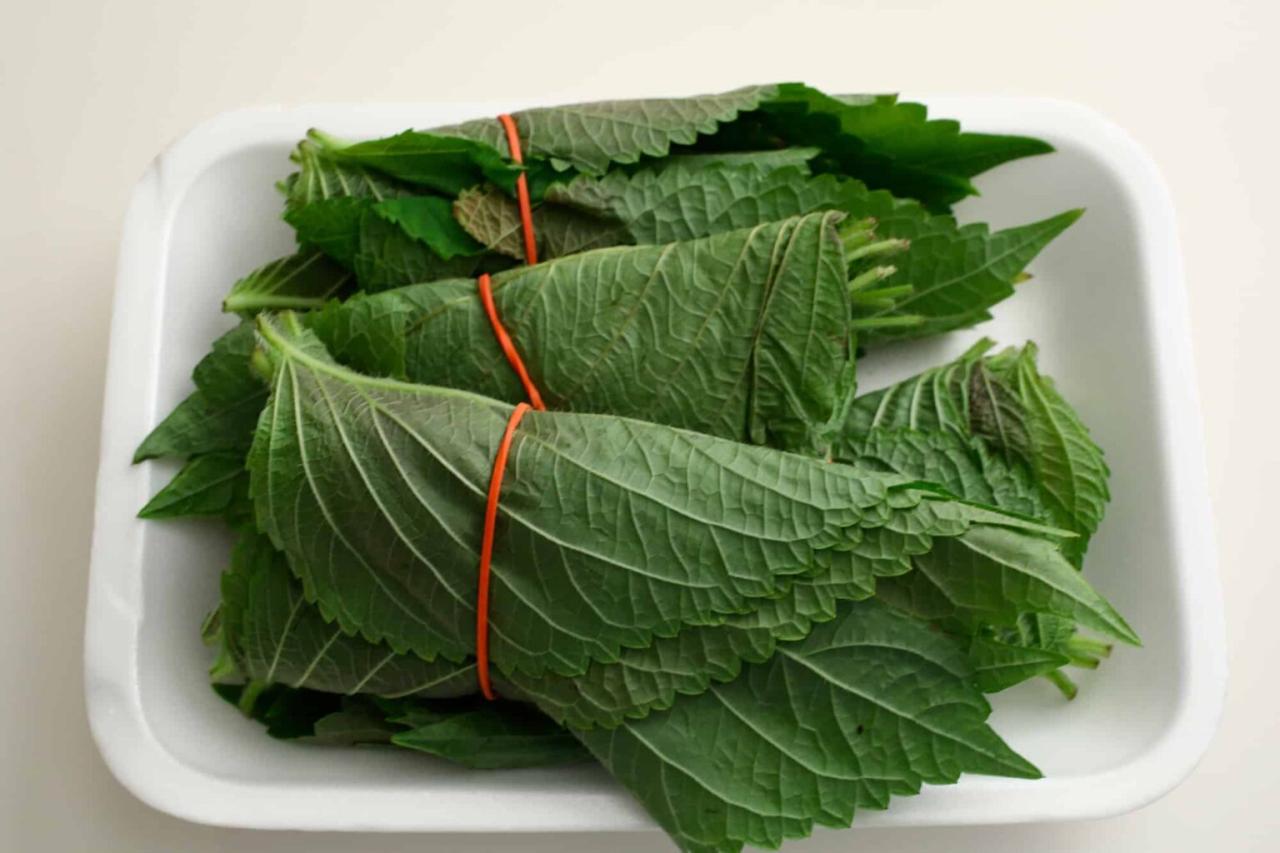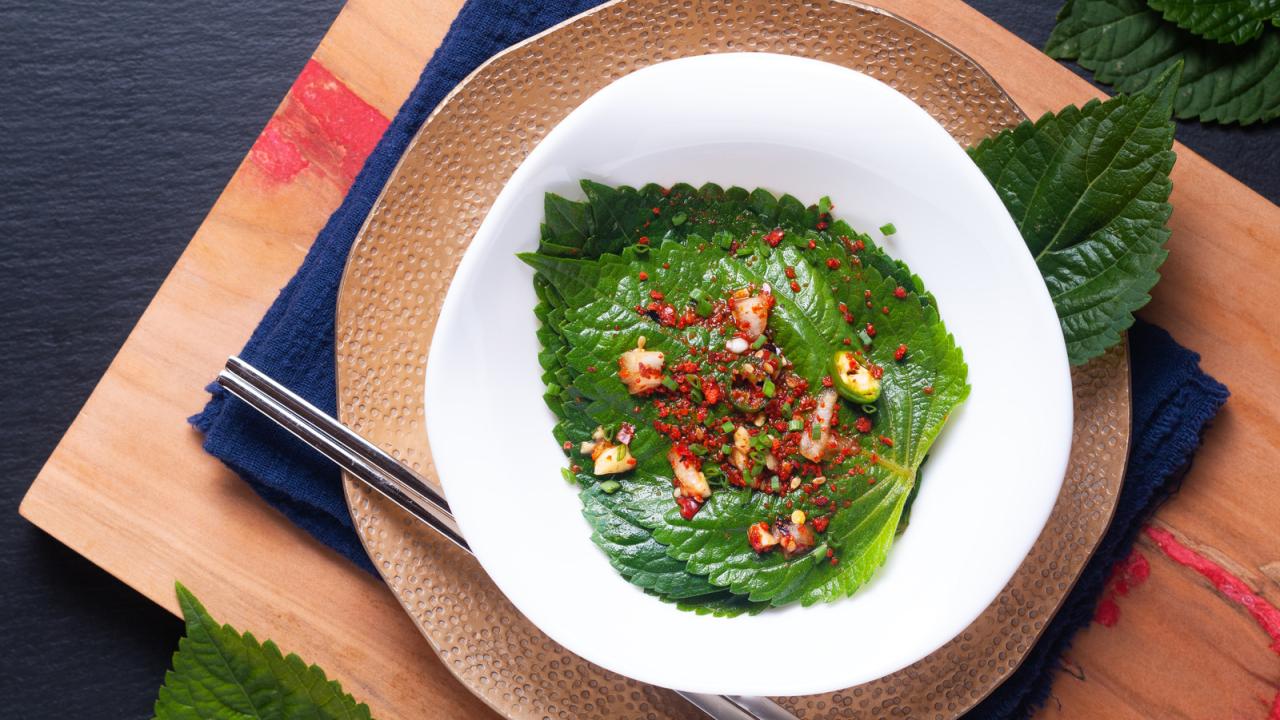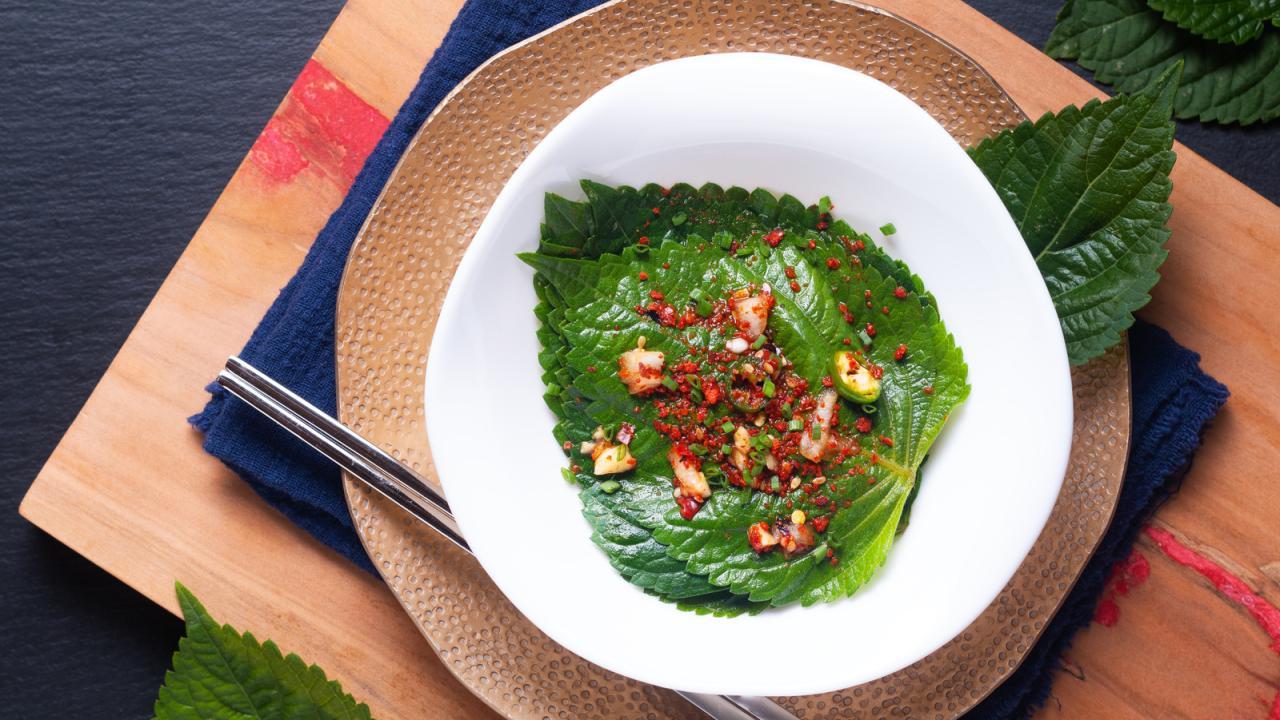Transform Your Cooking with Perilla Leaf: A Guide to Delicious Recipes sets the stage for this enthralling narrative, offering readers a glimpse into a story that is rich in detail and brimming with originality from the outset. Perilla leaf, also known as shiso, is a versatile herb with a unique flavor profile that can elevate any dish.
This guide explores the origins, culinary applications, and health benefits of this intriguing ingredient, providing a comprehensive resource for those seeking to expand their culinary horizons.
From its humble beginnings in East Asia to its growing popularity in modern kitchens worldwide, perilla leaf has captivated chefs and home cooks alike. This guide delves into the fascinating history of this herb, exploring its cultural significance and diverse culinary uses.
We will uncover the secrets behind its distinct flavor, a combination of minty, citrusy, and slightly spicy notes, and discover how it can be incorporated into a wide range of dishes.
Introduction to Perilla Leaf

Perilla leaf, also known as shiso, is a versatile herb with a long history and a unique flavor profile. Native to East Asia, this member of the mint family has been used for centuries in traditional medicine and cuisine. Its distinctive aroma, ranging from minty and citrusy to slightly peppery, has made it a popular ingredient in various dishes and beverages.
Perilla leaf, with its vibrant flavor and stunning color, can add a unique twist to your culinary repertoire. Like the similarly aromatic Kaffir Lime Leaf , perilla leaf offers a world of flavor possibilities, from savory stir-fries to refreshing salads.
Discover how to elevate your dishes with the distinct taste of perilla leaf in our comprehensive guide to delicious recipes.
Origin and History of Perilla Leaf
Perilla leaf has been cultivated in East Asia for centuries, with its origins traced back to China and Japan. Archaeological evidence suggests that it was used as early as the 3rd century BC in China. It was initially cultivated for its medicinal properties and later adopted as a culinary ingredient.
Perilla leaf spread throughout East Asia and gained popularity in countries like Korea, Vietnam, and Thailand. Its use in traditional medicine has been documented for various ailments, including respiratory issues, digestive problems, and skin conditions.
Flavor Profile and Culinary Uses
Perilla leaf boasts a complex and intriguing flavor profile. Its aroma and taste can vary depending on the variety and growing conditions. Generally, perilla leaf exhibits a combination of minty, citrusy, and slightly peppery notes. This unique flavor profile makes it a versatile ingredient that can be used in a variety of dishes.
Just like perilla leaf, kaffir lime leaf brings a unique aroma and flavor to dishes. If you’re looking to explore similar exotic ingredients, be sure to check out How to Incorporate Kaffir Lime Leaf into Your Cooking: Essential Tips and Recipes for inspiration.
Whether you’re seeking a subtle citrus note or a bold, herbaceous punch, perilla leaf offers a world of culinary possibilities waiting to be discovered.
Perilla leaf is commonly used as a garnish, adding a burst of flavor and color to various dishes. It is also used in salads, soups, and stir-fries. In Japanese cuisine, perilla leaf is known as shiso and is a key ingredient in dishes like shiso maki (sushi rolls with shiso leaves), shiso-age (deep-fried shiso leaves), and shiso-zuke (shiso pickles).
Korean cuisine also features perilla leaf extensively, particularly in kimchi (fermented cabbage). The leaves are also used to wrap fish and meat, imparting a unique flavor and aroma.
Nutritional Benefits and Health Properties
Perilla leaf is rich in nutrients and antioxidants, offering several potential health benefits. It is a good source of vitamins A, C, and K, as well as minerals like calcium, iron, and magnesium. Perilla leaf is also known for its high content of omega-3 fatty acids, particularly alpha-linolenic acid (ALA).
Research suggests that perilla leaf may have several health benefits, including:
- Anti-inflammatory properties:Perilla leaf contains compounds with anti-inflammatory effects, which may help reduce inflammation in the body.
- Antioxidant activity:The antioxidants in perilla leaf can help protect cells from damage caused by free radicals.
- Cardiovascular health:The omega-3 fatty acids in perilla leaf may help lower cholesterol levels and improve heart health.
- Cognitive function:Some studies suggest that perilla leaf may have beneficial effects on cognitive function and memory.
Culinary Applications of Perilla Leaf: Transform Your Cooking With Perilla Leaf: A Guide To Delicious Recipes

Perilla leaf, a versatile herb with a distinct aroma and flavor, has found its way into various cuisines around the world. From traditional Asian dishes to contemporary culinary creations, this leafy green adds a unique dimension to both savory and sweet recipes.
Perilla Leaf in Asian Cuisine
Perilla leaf is a staple ingredient in many Asian cuisines, particularly in East Asian countries like Korea, Japan, and China. Its distinct flavor profile, ranging from minty to slightly peppery, complements a wide range of dishes.
- In Korean cuisine, perilla leaf is often used as a garnish for grilled meats, such as bulgogi, and is also a key ingredient in the popular side dish, perilla leaf kimchi. It’s also used to flavor ssamjang, a dipping sauce commonly used with Korean BBQ.
- In Japanese cuisine, perilla leaf, known as shiso, is used in a variety of ways. It’s often used as a wrapper for maki sushi, where it adds a refreshing and slightly spicy element. Shiso is also used to flavor shiso-maki, a type of sushi roll that incorporates shiso leaves with rice and various fillings.
Shiso is also used in shiso pickles, a popular side dish that features pickled shiso leaves.
- In Chinese cuisine, perilla leaf, known as zi su, is often used as a flavoring agent in stir-fries, soups, and sauces. It’s particularly popular in Sichuan cuisine, where it’s used to enhance the flavor of spicy dishes.
Perilla Leaf in Western Cuisine
Perilla leaf is gaining popularity in Western cuisine as chefs explore its unique flavor profile and versatility. Its refreshing and slightly spicy notes make it a perfect addition to various dishes.
- Perilla leaf can be used as a garnish for grilled fish, chicken, and vegetables, adding a pop of color and flavor.
- It can be incorporated into salads, both raw and cooked, to add a unique and refreshing element.
- Perilla leaf can also be used in sauces, marinades, and dressings to add a touch of complexity and depth of flavor.
- Some chefs use perilla leaf to create unique flavor combinations in desserts, adding a touch of savory to sweet dishes.
Perilla Leaf in Other Cuisines, Transform Your Cooking with Perilla Leaf: A Guide to Delicious Recipes
Perilla leaf has also found its way into cuisines beyond Asia and the West.
- In Southeast Asian cuisine, perilla leaf is often used in Vietnamese dishes like goi cuon, a fresh spring roll, and banh mi, a popular Vietnamese sandwich.
- In India, perilla leaf is sometimes used in curries and other dishes, adding a unique flavor dimension.
Recipes Using Perilla Leaf
Cuisine |
Recipe |
Preparation Method |
|---|---|---|
Korean |
Perilla Leaf Kimchi |
Fermented |
Japanese |
Shiso-Maki |
Sushi roll |
Chinese |
Sichuan Spicy Fish with Perilla Leaf |
Stir-fry |
Western |
Grilled Salmon with Perilla Leaf Garnish |
Grilled |
Vietnamese |
Goi Cuon (Fresh Spring Roll) |
Wrapped |
Delicious Perilla Leaf Recipes

Perilla leaf, with its unique flavor and versatility, can be incorporated into a wide range of culinary creations. From appetizers to main courses and even desserts, this herb offers a delightful twist to your favorite dishes. Explore the diverse world of perilla leaf recipes, and discover new ways to elevate your culinary repertoire.
Appetizers
Perilla leaf’s distinct aroma and taste make it an ideal ingredient for appetizers. Its refreshing, slightly peppery flavor adds a unique dimension to various dishes.
- Perilla Leaf and Shrimp Spring Rolls:These spring rolls are a delightful fusion of flavors and textures. The crispness of the perilla leaves complements the juicy shrimp and the savory dipping sauce.
- Perilla Leaf and Tofu Salad:This refreshing salad is a light and healthy option. The perilla leaf adds a unique flavor and aroma, while the tofu provides a source of protein.
- Perilla Leaf and Sesame Oil Dip:This simple yet flavorful dip is perfect for dipping vegetables, crackers, or even meats. The perilla leaf’s aroma blends perfectly with the sesame oil, creating a delicious and aromatic dip.
Main Courses
Perilla leaf can be used in various main courses, adding a unique flavor profile to both Asian-inspired and Western dishes.
- Grilled Salmon with Perilla Leaf Sauce:This dish combines the rich flavor of grilled salmon with a vibrant perilla leaf sauce. The sauce adds a refreshing and slightly spicy element to the dish.
- Chicken Stir-Fry with Perilla Leaf and Ginger:This quick and easy stir-fry is packed with flavor. The perilla leaf adds a unique aroma, while the ginger provides a warming element.
- Perilla Leaf and Pork Dumplings:These dumplings are a flavorful and satisfying meal. The perilla leaf adds a unique flavor to the filling, while the dumplings are steamed to perfection.
Desserts
Perilla leaf can even be incorporated into desserts, adding a surprising and refreshing twist.
- Perilla Leaf and Green Tea Ice Cream:This unique ice cream combines the refreshing flavors of perilla leaf and green tea. The perilla leaf adds a subtle peppery note, while the green tea provides a calming and earthy flavor.
- Perilla Leaf and Mango Sticky Rice:This traditional Thai dessert gets a unique twist with the addition of perilla leaf. The perilla leaf adds a subtle peppery note, while the mango and sticky rice provide a sweet and creamy contrast.
- Perilla Leaf and Chocolate Cake:This unexpected pairing creates a delicious and surprising dessert. The perilla leaf adds a unique aroma and flavor, while the chocolate provides a rich and decadent base.
Table of Recipes
Recipe |
Image |
Description |
|---|---|---|
Perilla Leaf and Shrimp Spring Rolls |
[Image of Perilla Leaf and Shrimp Spring Rolls] |
These spring rolls are a delightful fusion of flavors and textures. The crispness of the perilla leaves complements the juicy shrimp and the savory dipping sauce. |
Perilla Leaf and Tofu Salad |
[Image of Perilla Leaf and Tofu Salad] |
This refreshing salad is a light and healthy option. The perilla leaf adds a unique flavor and aroma, while the tofu provides a source of protein. |
Perilla Leaf and Sesame Oil Dip |
[Image of Perilla Leaf and Sesame Oil Dip] |
This simple yet flavorful dip is perfect for dipping vegetables, crackers, or even meats. The perilla leaf’s aroma blends perfectly with the sesame oil, creating a delicious and aromatic dip. |
Grilled Salmon with Perilla Leaf Sauce |
[Image of Grilled Salmon with Perilla Leaf Sauce] |
This dish combines the rich flavor of grilled salmon with a vibrant perilla leaf sauce. The sauce adds a refreshing and slightly spicy element to the dish. |
Chicken Stir-Fry with Perilla Leaf and Ginger |
[Image of Chicken Stir-Fry with Perilla Leaf and Ginger] |
This quick and easy stir-fry is packed with flavor. The perilla leaf adds a unique aroma, while the ginger provides a warming element. |
Perilla Leaf and Pork Dumplings |
[Image of Perilla Leaf and Pork Dumplings] |
These dumplings are a flavorful and satisfying meal. The perilla leaf adds a unique flavor to the filling, while the dumplings are steamed to perfection. |
Perilla Leaf and Green Tea Ice Cream |
[Image of Perilla Leaf and Green Tea Ice Cream] |
This unique ice cream combines the refreshing flavors of perilla leaf and green tea. The perilla leaf adds a subtle peppery note, while the green tea provides a calming and earthy flavor. |
Perilla Leaf and Mango Sticky Rice |
[Image of Perilla Leaf and Mango Sticky Rice] |
This traditional Thai dessert gets a unique twist with the addition of perilla leaf. The perilla leaf adds a subtle peppery note, while the mango and sticky rice provide a sweet and creamy contrast. |
Perilla Leaf and Chocolate Cake |
[Image of Perilla Leaf and Chocolate Cake] |
This unexpected pairing creates a delicious and surprising dessert. The perilla leaf adds a unique aroma and flavor, while the chocolate provides a rich and decadent base. |
Tips for Using Perilla Leaf in Cooking
Perilla leaf, with its unique flavor and versatility, can elevate your dishes to new heights. Whether you’re grilling, frying, or pickling, understanding how to select, store, and prepare this aromatic herb is key to unlocking its full potential.
Selecting and Storing Perilla Leaves
Choosing fresh, high-quality perilla leaves is essential for optimal flavor and quality. Here’s a guide to selecting and storing these aromatic leaves:
- Look for vibrant green leaves:Fresh perilla leaves should be a vibrant green, free from any signs of wilting or yellowing.
- Avoid leaves with blemishes:Inspect the leaves for any holes, brown spots, or other blemishes that may indicate damage or spoilage.
- Store properly for freshness:Wrap perilla leaves in a damp paper towel and store them in a plastic bag in the refrigerator. They can last for up to a week this way.
Preparing Perilla Leaves for Cooking
Perilla leaves can be incorporated into a variety of dishes, from salads to stir-fries. Here’s how to prepare them for different culinary applications:
- Grilling:For grilling, simply brush the leaves with a light coating of oil and grill for a few minutes per side until slightly charred.
- Frying:Deep-fry perilla leaves for a crispy and flavorful snack. Use a light batter or tempura batter for optimal results.
- Pickling:Perilla leaves can be pickled to preserve their flavor and create a unique condiment. A simple pickling brine of vinegar, sugar, and salt will do the trick.
Balancing Perilla Leaf Flavor
Perilla leaf has a distinctive, slightly minty and peppery flavor that can be overpowering if not balanced correctly. Here are some tips for incorporating perilla leaf into your dishes without overwhelming the other flavors:
- Start with small amounts:Begin by adding a small amount of perilla leaf to your dish and gradually increase the amount to taste.
- Pair with complementary flavors:Perilla leaf pairs well with other Asian-inspired flavors, such as soy sauce, ginger, garlic, and sesame oil.
- Use it as a garnish:Add a few perilla leaves as a garnish to your dishes to add a burst of flavor and color.
Perilla Leaf in Modern Cuisine
Perilla leaf, once a staple in Asian cuisine, has experienced a surge in popularity within contemporary gastronomy. Chefs worldwide are recognizing its unique flavor profile and versatility, incorporating it into innovative dishes that tantalize the palate and redefine culinary boundaries.
This exploration delves into the rising prominence of perilla leaf in modern cuisine, highlighting the innovative ways chefs are utilizing it to create unforgettable culinary experiences.
Innovative Uses of Perilla Leaf in Modern Cuisine
The culinary world is embracing perilla leaf’s versatility, utilizing it in diverse ways to enhance dishes. Chefs are experimenting with perilla leaf beyond its traditional applications, incorporating it into various culinary creations.
- Infused Oils and Vinegars:Perilla leaf’s distinctive aroma and flavor lend themselves well to oil and vinegar infusions. Chefs infuse oils with perilla leaf to create vibrant dressings for salads and marinades for meats and seafood. Perilla leaf vinegar adds a complex, herbaceous note to sauces and vinaigrettes.
- Flavoring Agents in Cocktails and Mocktails:Perilla leaf’s aromatic qualities extend beyond the realm of food. Mixologists are incorporating perilla leaf into cocktails and mocktails, adding a refreshing, herbaceous twist to their creations. Perilla leaf can be muddled with other ingredients, infused into syrups, or used as a garnish to enhance the flavor profile of drinks.
- Unique Flavor Combinations:Chefs are pushing the boundaries of flavor combinations, pairing perilla leaf with unexpected ingredients to create harmonious and intriguing taste experiences. For example, perilla leaf complements the richness of fatty fish like salmon and tuna, while its bright, citrusy notes enhance the flavor of grilled chicken and pork.
Wrap-Up
Transform Your Cooking with Perilla Leaf: A Guide to Delicious Recipes concludes with a tantalizing exploration of the herb’s potential in modern cuisine. As chefs continue to innovate and push the boundaries of culinary creativity, perilla leaf is emerging as a key ingredient for crafting unique and unforgettable flavor profiles.
Whether you’re a seasoned chef or a home cook looking for inspiration, this guide provides the tools and knowledge you need to unlock the full potential of perilla leaf and elevate your culinary creations to new heights.
Query Resolution
Where can I find fresh perilla leaves?
Fresh perilla leaves can be found at Asian grocery stores, specialty markets, and some farmers markets. You may also be able to find them online.
Can I substitute perilla leaf for another herb in a recipe?
While perilla leaf has a unique flavor, you can substitute it with other herbs like basil, mint, or cilantro in some dishes. However, the flavor profile will be different.
How long can I store fresh perilla leaves?
Fresh perilla leaves can be stored in the refrigerator for up to a week if wrapped in a damp paper towel. For longer storage, you can freeze them.
Are there any health benefits to eating perilla leaf?
Perilla leaf is a good source of antioxidants and has been shown to have anti-inflammatory properties. It is also known to aid in digestion.
